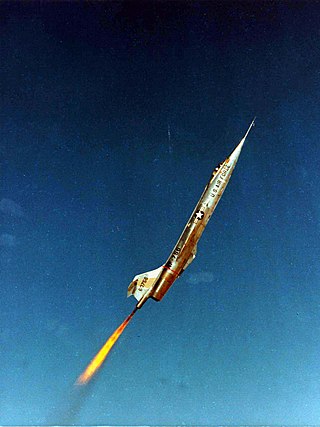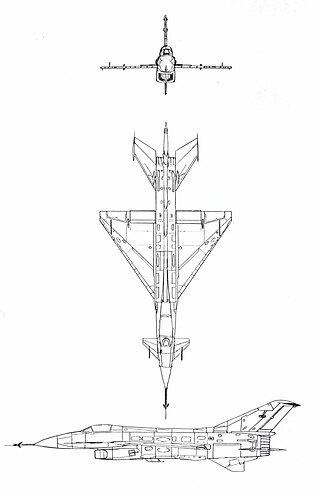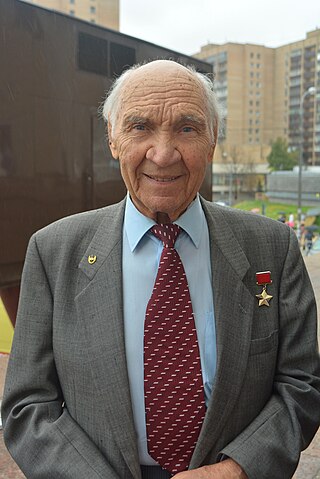
The Gloster Meteor was the first British jet fighter and the Allies' only jet aircraft to engage in combat operations during the Second World War. The Meteor's development was heavily reliant on its ground-breaking turbojet engines, pioneered by Frank Whittle and his company, Power Jets Ltd. Development of the aircraft began in 1940, although work on the engines had been under way since 1936.

The Mikoyan-Gurevich MiG-19 is a Soviet second generation, single-seat, twinjet fighter aircraft. It was the first Soviet production aircraft capable of supersonic speeds in level flight. A comparable U.S. "Century Series" fighter was the North American F-100 Super Sabre, although the MiG-19 primarily fought against the more modern McDonnell Douglas F-4 Phantom II and Republic F-105 Thunderchief over North Vietnam. This aircraft was originally used by the Soviet Union but it was later used by the People's Liberation Army Air Force of China.

The Lockheed F-104 Starfighter is an American single-engine, supersonic interceptor which was extensively deployed as a fighter-bomber during the Cold War. Created as a day fighter by Lockheed as one of the "Century Series" of fighter aircraft for the United States Air Force (USAF), it was developed into an all-weather multirole aircraft in the early 1960s and produced by several other nations, seeing widespread service outside the United States.

The English Electric Lightning is a British fighter aircraft that served as an interceptor during the 1960s, the 1970s and into the late 1980s. It was capable of a top speed of above Mach 2. The Lightning was designed, developed, and manufactured by English Electric. After EE merged with other aircraft manufacturers to form the British Aircraft Corporation it was marketed as the BAC Lightning. It was operated by the Royal Air Force (RAF), the Kuwait Air Force (KAF), and the Royal Saudi Air Force (RSAF).

The Tupolev Tu-104 is a retired medium-range, narrow-body, twin turbojet-powered Soviet airliner. It was the second to enter regular service, behind the British de Havilland Comet and was the only jetliner operating in the world from 1956 to 1958, when the British jetliner was grounded due to safety concerns.

The Mikoyan-Gurevich MiG-25 is a supersonic interceptor and reconnaissance aircraft that is among the fastest military aircraft to enter service. Designed by the Soviet Union's Mikoyan-Gurevich bureau, it is an aircraft built primarily using stainless steel. It was to be the last plane designed by Mikhail Gurevich, before his retirement.

The Mikoyan-Gurevich MiG-9 was the first turbojet fighter developed by Mikoyan-Gurevich in the years immediately after World War II. It used reverse-engineered German BMW 003 engines. Categorized as a first-generation jet fighter, it suffered from persistent problems with engine flameouts when firing its guns at high altitudes due to gun gas ingestion. A number of different armament configurations were tested, but none solved the problem. Several different engines were evaluated, but none were flown as the prototype of the MiG-15 promised superior performance.

The Mikoyan-Gurevich I-250, aka MiG-13, was a Soviet fighter aircraft developed as part of a crash program in 1944 to develop a high-performance fighter to counter German turbojet-powered aircraft such as the Messerschmitt Me 262. The Mikoyan-Gurevich design bureau decided to focus on a design that used something more mature than the jet engine, which was still at an experimental stage in the Soviet Union, and chose a mixed-power solution with the VRDK motorjet powered by the Klimov VK-107 V12 engine. While quite successful when it worked, with a maximum speed of 820 km/h (510 mph) being reached during trials, production problems with the VRDK fatally delayed the program and it was canceled in 1948 as obsolete.

Aerobatic maneuvers are flight paths putting aircraft in unusual attitudes, in air shows, dogfights or competition aerobatics. Aerobatics can be performed by a single aircraft or in formation with several others. Nearly all aircraft are capable of performing aerobatics maneuvers of some kind, although it may not be legal or safe to do so in certain aircraft.

An air speed record is the highest airspeed attained by an aircraft of a particular class. The rules for all official aviation records are defined by Fédération Aéronautique Internationale (FAI), which also ratifies any claims. Speed records are divided into multiple classes with sub-divisions. There are three classes of aircraft: landplanes, seaplanes, and amphibians; then within these classes, there are records for aircraft in a number of weight categories. There are still further subdivisions for piston-engined, turbojet, turboprop, and rocket-engined aircraft. Within each of these groups, records are defined for speed over a straight course and for closed circuits of various sizes carrying various payloads.

This listing of flight altitude records are the records set for the highest aeronautical flights conducted in the atmosphere, set since the age of ballooning.

The Lockheed XF-104 Starfighter was a single-engine, high-performance, supersonic interceptor prototype for a United States Air Force (USAF) series of lightweight and simple fighters. Only two aircraft were built; one aircraft was used primarily for aerodynamic research and the other served as an armament testbed, both aircraft being destroyed in accidents during testing. The XF-104s were forerunners of over 2,500 production Lockheed F-104 Starfighters.

The Lockheed NF-104A was an American mixed-power, high-performance, supersonic aerospace trainer that served as a low-cost astronaut training vehicle for the North American X-15 and projected Boeing X-20 Dyna-Soar programs.

The General Dynamics X-62 VISTA is an experimental aircraft, derived from the F-16D Fighting Falcon, which was modified as a joint venture between General Dynamics and Calspan for use by the United States Air Force (USAF). Originally designated NF-16D, the aircraft was redesignated X-62A on 14 June 2021 as part of an upgrade to a Skyborg, with System for Autonomous Control of Simulation (SACS).

The Mikoyan-Gurevich Ye-8 was a supersonic jet fighter developed in the Soviet Union, intended to replace the MiG-21. Only two prototypes were built in 1960–61. The original MiG-21's air intakes were moved under the fuselage, freeing up the nose where a larger and more powerful radar, able to deliver longer range air-to-air missiles, could be built in. Canards were built to both sides of the nose, in front of the cockpit,.

The Mikoyan-Gurevich I-320 was a prototype Soviet long-range all-weather interceptor aircraft of the late 1940s-early 1950s. Only two were made, with no production following.
The Red Baron was a highly modified Lockheed F-104 Starfighter which set a FAI Class C-1 Group III 3 km speed record of 1,590.45 kilometres per hour (988.26 mph), in 1977 which still stands. It was assembled by Darryl Greenamyer and sponsored by Ed Browning and the Red Baron Flying Service of Idaho Falls, Idaho. The aircraft was destroyed in an accident in 1978.

Georgy Konstantinovich Mosolov was a Soviet Russian test pilot. He attained the rank of Polkovnik (Colonel). He attained two world air speed records, in either the Mikoyan MiG-21 or the prototype Mikoyan Ye-66, as well as one altitude record. Colonel Mosolov was awarded the Hero of the Soviet Union and the Lenin Prize.

Aeroflot Flight 04 was a scheduled domestic passenger flight from Khabarovsk to Moscow with a stopover in Irkutsk that crashed on 15 August 1958, killing all 64 passengers and crew aboard the aircraft. It was the first fatal accident involving a Tupolev Tu-104.


















